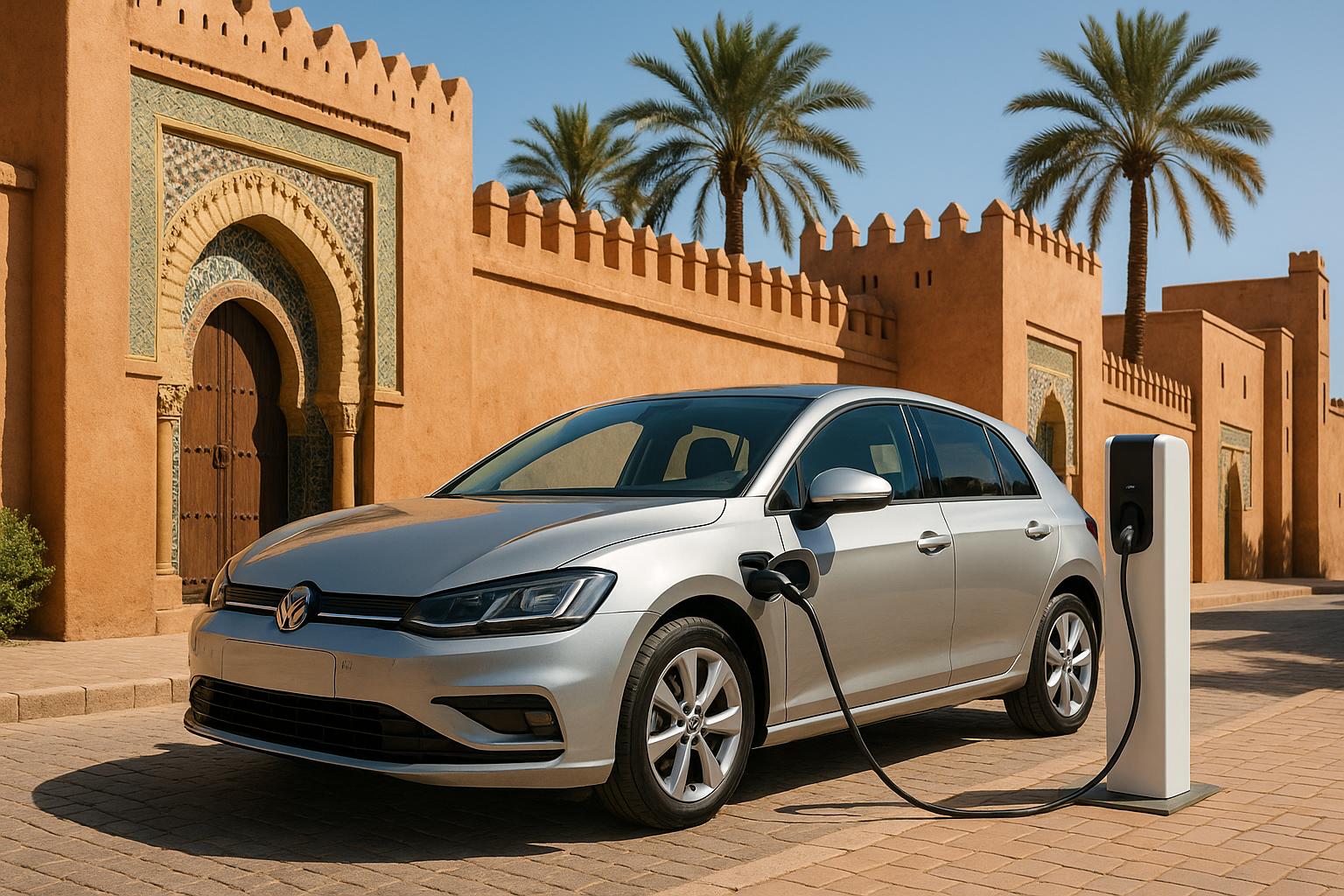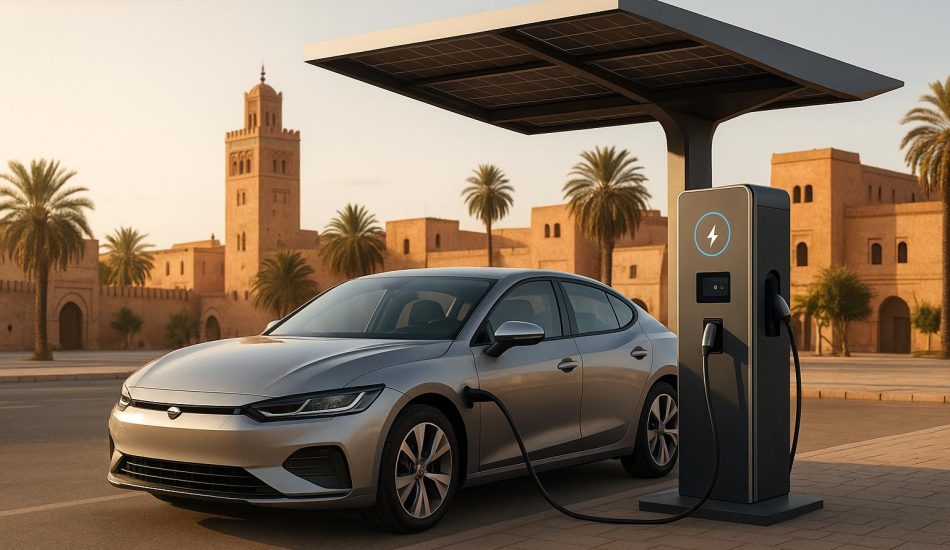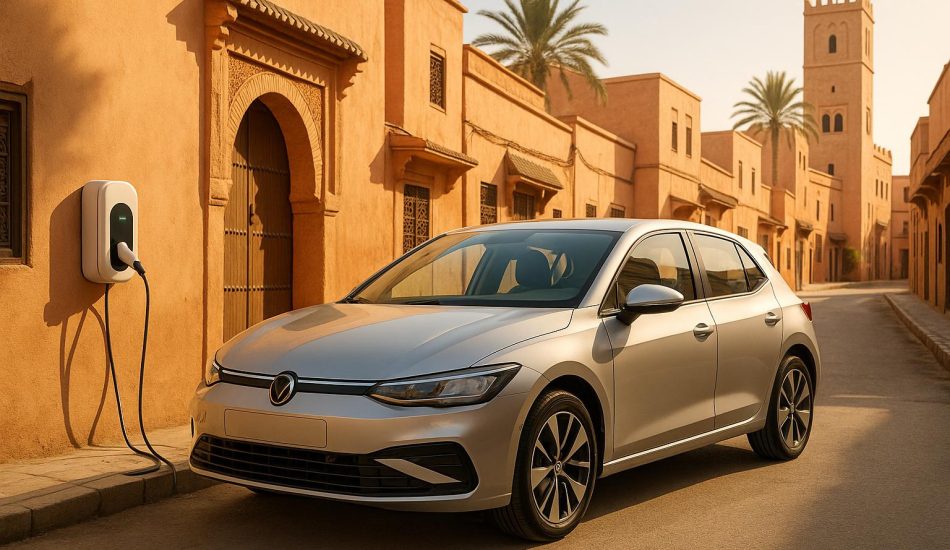
Electric cars are gaining traction in Morocco, driven by government incentives, expanding infrastructure, and a push for cleaner transportation. However, owning an EV comes with both benefits and challenges. Here’s what you need to know:
Key Points:
- Cost: EVs are more expensive upfront (e.g., Dacia Spring BEV starts at ~$22,350), but they save money on fuel (43 miles per $1 vs. 10 miles per $1 for gas cars) and maintenance.
- Charging: Urban areas like Casablanca have growing charging networks, but rural coverage is limited. Home charging is an option but may require electrical upgrades.
- Environment: EVs produce no tailpipe emissions, helping reduce pollution, especially as Morocco increases renewable energy use.
- Practical Challenges: Range anxiety, limited service centers, and slower charging times can be hurdles. Gas-powered cars remain more convenient for long trips and rural areas.
Quick Comparison:
| Aspect | Electric Cars | Gas-Powered Cars |
|---|---|---|
| Initial Cost | Higher purchase price | Lower purchase price |
| Operating Costs | Lower (cheaper fuel, less maintenance) | Higher (fuel and frequent repairs) |
| Range | 150-300 miles, slower recharging | 300-500 miles, quick refueling |
| Infrastructure | Limited charging stations | Nationwide gas stations |
| Environmental Impact | Zero emissions | High emissions |
For city drivers with predictable commutes, EVs are becoming a practical choice despite higher initial costs. Rural drivers or those traveling long distances may find gas-powered cars more suitable for now. As Morocco continues investing in EV infrastructure, the balance may shift further toward electric vehicles.
1. Electric Cars in Morocco
Cost-Effectiveness
When it comes to electric vehicles (EVs) in Morocco, the financial picture is a bit of a balancing act. On one hand, the upfront costs are noticeably higher than those of traditional gasoline-powered cars. For instance, premium models like the BMW i4 BEV start at MAD 815,000 (about $81,500), and the Audi e-tron is priced at MAD 1,050,000 (around $105,000). On the more affordable end, the Dacia Spring BEV begins at MAD 223,500 (roughly $22,350). These price tags can make EV ownership feel out of reach for many.
However, the story changes when you look at operating costs. EVs deliver impressive savings in this area, offering about 43 miles of driving per dollar, compared to just 10 miles per dollar for gasoline vehicles. Morocco’s green electricity subsidies also help keep charging costs low, averaging around $0.02 per kilowatt-hour. Plus, EVs generally require less maintenance – no oil changes, spark plugs, or exhaust system repairs – making them easier on the wallet over time. While the initial investment is steep, the long-term savings can make EVs an appealing choice for some.
Charging Infrastructure
Morocco’s charging infrastructure is steadily improving, particularly in major cities like Casablanca, Rabat, and Marrakech. That said, rural areas still face limited coverage, which can make EV ownership less practical for those outside urban centers. For many, home charging is a convenient option, especially with subsidized electricity rates and the ability to charge overnight. However, setting up a home charging station might require some modifications to the existing electrical system.
Public charging networks, while growing, can vary in terms of speed and availability. This means EV owners often need to plan ahead for longer trips. Ultimately, the ease of access to charging plays a key role in how practical EVs are for day-to-day use.
Environmental Impact
One of the biggest draws of electric vehicles is their ability to reduce air pollution, particularly in cities, since they produce zero tailpipe emissions. As Morocco continues to increase its reliance on renewable energy for electricity generation, the environmental advantages of EVs are expected to grow even further. While these benefits are promising, they don’t come without challenges for owners.
Practical Challenges
For many potential EV buyers, range anxiety remains a real concern, especially for trips outside of urban hubs where charging stations are less common. Another hurdle is the limited availability of specialized service centers, which can sometimes lead to delays in repairs. These factors highlight some of the practical issues that still need to be addressed to make EV ownership more seamless in Morocco.
Morocco 🇲🇦 with a Tesla #travel #tesla #explore #nature #adventure
2. Gas-Powered Cars in Morocco
Gas-powered cars still dominate the streets of Morocco, but they come with growing challenges. Rising fuel prices and maintenance costs are increasingly straining the budgets of car owners. While electric vehicles promise savings and reduced environmental impact over time, gas-powered cars continue to face mounting economic and ecological pressures.
Cost-Effectiveness
Owning a gas-powered car in Morocco has become a costly affair. One major factor is the volatile fuel prices, which make it difficult for drivers to predict and manage their monthly transportation expenses. This unpredictability complicates budgeting for many households.
On top of fuel costs, maintenance expenses add a significant financial burden. Regular oil changes, replacing filters and spark plugs, servicing brakes, and addressing exhaust system issues all contribute to the long-term costs of keeping a gas-powered car on the road.
Environmental Impact
Gas-powered vehicles are a major contributor to Morocco’s carbon emissions. Unlike alternatives that produce no tailpipe emissions, traditional gasoline engines release harmful pollutants into the atmosphere with every mile driven. This makes the transport sector a key player in the country’s environmental challenges.
Practical Challenges
While Morocco has a well-established fueling infrastructure for gas-powered cars, owners still face practical difficulties. The unpredictability of fuel prices creates financial uncertainty, making it harder to plan for transportation costs. This adds another layer of inconvenience to owning a gas-powered vehicle in the country.
sbb-itb-99e19e3
Pros and Cons Comparison
Deciding between electric and gas-powered cars in Morocco involves balancing factors like cost, convenience, and environmental impact.
Electric cars typically come with a higher upfront price tag, but they can save money over time thanks to lower fuel and maintenance expenses. On the other hand, gas-powered cars are more affordable initially but come with fluctuating fuel prices and ongoing maintenance costs.
One of the biggest practical differences lies in infrastructure. Gas stations are easy to find across Morocco, while charging stations for electric vehicles are still sparse, especially outside major cities. This difference can significantly influence travel plans and confidence in reaching your destination.
Here’s a quick comparison of key aspects:
| Aspect | Electric Cars | Gas-Powered Cars |
|---|---|---|
| Initial Cost | Higher purchase price, possible incentives | Lower purchase price, easily financed |
| Operating Costs | Lower electricity costs, minimal maintenance | Rising fuel prices, regular maintenance |
| Environmental Impact | Zero emissions, cleaner air | High emissions, contributes to pollution |
| Infrastructure | Limited charging stations, mostly in cities | Nationwide gas station availability |
| Convenience | Home charging, slower refueling | Quick refueling, widely familiar |
| Maintenance | Fewer parts, less frequent servicing | Regular oil changes and repairs |
| Range Anxiety | Shorter range, charging requires planning | Longer range, refueling is easy |
| Technology | Advanced features, smartphone integration | Traditional systems, reliable and tested |
When it comes to environmental impact, the difference is striking. Electric vehicles produce zero tailpipe emissions, which means cleaner air in Morocco’s cities. Gas-powered cars, however, contribute to carbon emissions and play a role in air pollution challenges.
Range and convenience are other critical factors. Electric cars typically offer a range of 150-300 miles, but charging can take anywhere from 30 minutes to several hours. In contrast, gas-powered cars can travel 300-500 miles on a full tank and refuel in under five minutes at any of Morocco’s numerous gas stations.
For urban drivers with predictable commutes and access to home charging, electric cars are becoming a more practical option. However, if you frequently travel long distances or live in areas without charging infrastructure, gas-powered vehicles may still be the better choice. Carefully weigh these factors to decide which option aligns best with your lifestyle and needs.
Conclusion
Deciding whether to switch to an electric car in Morocco comes down to your specific driving habits and the local infrastructure available to you. While electric vehicles bring clear perks, gas-powered cars remain more practical for those who frequently travel long distances or live in areas with limited charging options. These realities shape the choice for drivers navigating Morocco’s diverse conditions.
For urban drivers with consistent daily commutes, electric cars are particularly appealing. Home charging offers the convenience of overnight refueling and shields drivers from the unpredictability of gas prices. Despite the higher upfront cost, this can translate into considerable financial savings over time.
Although electric cars require a larger initial investment, the savings on fuel and maintenance can make up for it in the long run. For those who primarily drive in cities, the financial benefits over several years often outweigh the initial expense.
Morocco’s electric vehicle market is growing at a fast pace. As charging networks expand and more budget-friendly models hit the market, the appeal of electric vehicles will continue to rise. If you’re not ready to make the leap just yet, staying informed about these advancements will help you decide when the timing is right.
Ultimately, the best choice depends on your lifestyle. For many Moroccan drivers, the advantages of electric vehicles are already tipping the scales, and this shift is likely to accelerate in the near future.
FAQs
What are the long-term financial advantages of owning an electric car in Morocco compared to a gas-powered vehicle?
Owning an electric car in Morocco can save you a lot of money in the long run. Charging your car at home is much cheaper compared to filling up with gas, especially as fuel prices continue to climb. Plus, electric vehicles are built with fewer moving parts, which translates to lower maintenance costs and fewer surprise repairs. All of this adds up to make EVs a cost-effective option for long-term ownership.
What is the current state of charging infrastructure for electric vehicles in rural Morocco?
The development of charging infrastructure for electric vehicles (EVs) in rural Morocco is still in its infancy. While urban areas are gradually benefiting from an uptick in charging stations, rural regions lag behind due to limited accessibility and slower infrastructure rollout.
Although steps are being taken to bridge these gaps, EV owners in Morocco’s rural areas currently need to plan their journeys with care, relying on charging points available in nearby towns or cities. With the market expanding and government programs gaining momentum, rural regions are likely to see improvements over time.
What should you know about maintaining an electric car in Morocco?
Electric cars typically need less maintenance than traditional gas-powered vehicles. Why? They have fewer moving parts and skip services like oil changes altogether. But in Morocco, potential EV owners should consider a key factor: specialized service centers for electric vehicles might not be widely available in all regions.
If you’re thinking about buying an EV, take some time to look into the local availability of certified technicians and spare parts. This is especially important if you live outside major cities, where finding EV support could be more challenging. A little research and planning can save you from unexpected delays or extra costs down the road.




